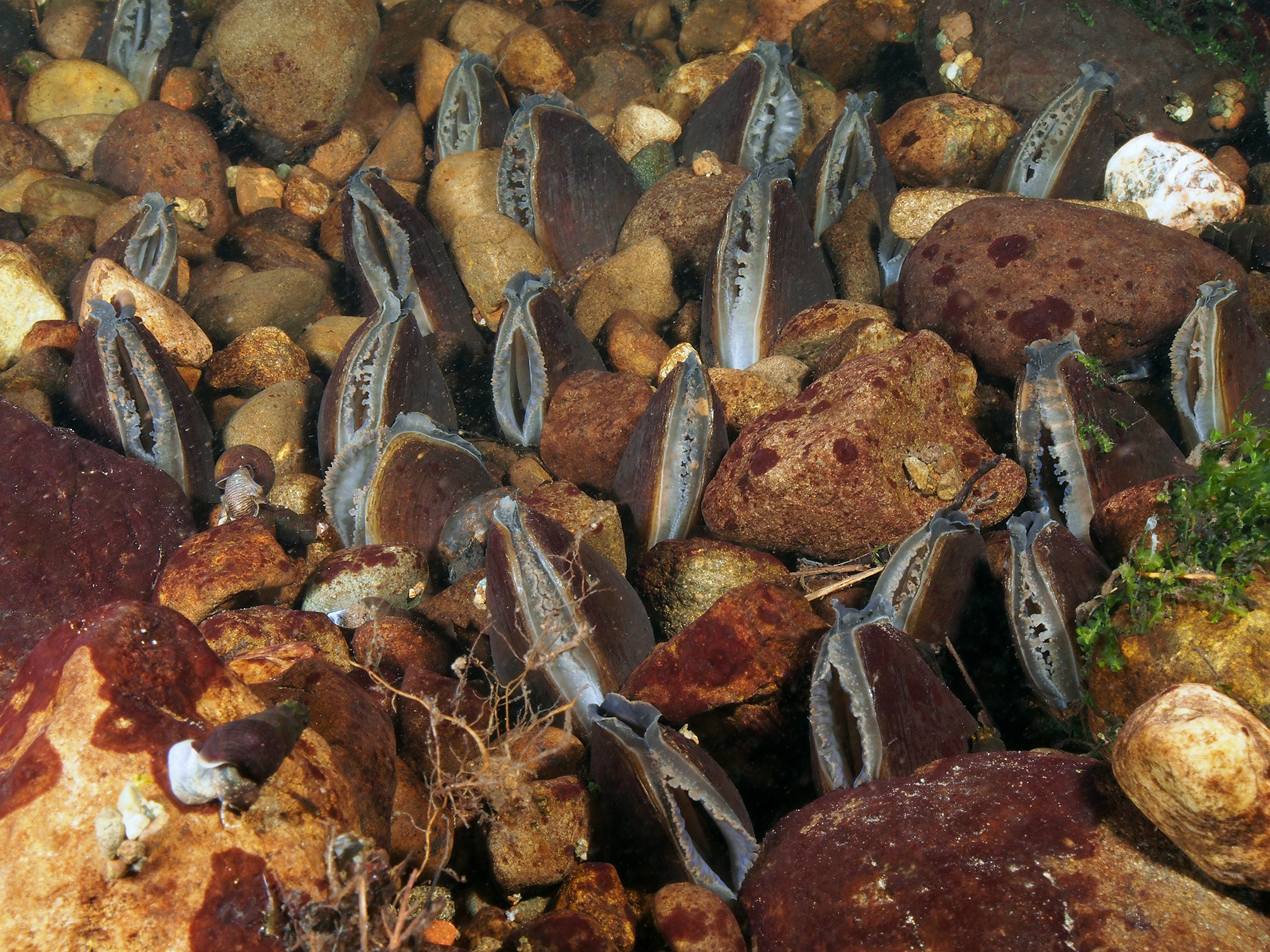The U.S. Fish and Wildlife Service (USFWS) recently announced plans to remove nearly two dozen plants and animals from the list of endangered and threatened species, not because they have been “recovered,” but because they are believed to be extinct. Much of that media focused on the ivory-billed woodpecker, but a third of the species were freshwater mussels: flat pigtoe, southern acornshell, upland combshell, turgid blossom, and four others.
For a continent rich in biodiversity, this act of record-keeping highlights the imperilment faced by invertebrates and foreshadows our future should we fail to act, especially with respect to freshwater mussels. More than 30 species (greater than 10%) of North America’s freshwater mussels are gone forever, and more than 90 are found on the USFWS list, either as endangered or threatened. For biologists and the many people who recognize the inherent value of biodiversity and rare species, the conservation of freshwater mussels and preservation of their habitat is easy to understand. These are animals that share our rivers and enrich our natural and cultural connections.

Bed of western pearlshell freshwater mussels. These little bivalves are powerhouses of filtration. By filtering water, cycling nutrients, and burrowing in river bottoms, freshwater mussels both improve and create aquatic habitat for fish, mammals, other macroinvertebrates, and people. (Photo: Roger Tabor / USFWS.)
Yet, there are also more concrete and definable reasons to value them, and it is important to consider these as we make decisions about which land- or river-scapes matter to us, which we value. Unless we recognize these values, we are unable to make informed decisions when it comes to water use, habitat restoration, water quality, and fisheries management, and these decisions become ever more important as we face the challenges of increased urban and agricultural development and climate change.
Freshwater mussels act as Brita filters, taking in water and purifying it through filtration. Estimates of the volume of water filtered by a single mussel varies by species as well as the number of mussels found in an area, but it is estimated to be between 10 and 20 gallons of water a day. This can translate to filtering more than the daily stream discharge in some rivers and streams. And, because healthy populations can occur as dense beds of hundreds or thousands of mussels, in some habitats they can comprise as much as a quarter of macrobenthic (large, bottom-dwelling life) biomass. Though mussels are filtering water in order to breathe and feed, as they do so, they provide other benefits, such as the removal of suspended sediments, which consist of things we can see like soil particles and debris, as well as things much too small to see, such as pollutants and bacteria. For example, recent research has shown that mussels can remove pharmaceuticals and personal care products, among other contaminants, from our waterways. In fact, one estimate of mussel filtering capacity in the Mississippi River totaled 53 million cubic meters per day. Compare that to a wastewater treatment plant that, for example, might have a capacity of just 0.7 million cubic meters per day.
If you enjoy eating fish or happen to be an angler, it may surprise you to know that freshwater mussels provide important benefits to fish, beyond improved water quality. It is well-established that fish are important to freshwater mussels; indeed, mussels rely on host fish to complete their life-cycle. However, recent research is showing that freshwater mussels can help fish survive droughts and bacterial infections, and they can help supplement food for fish by promoting abundance of macroinvertebrates that are important to fish diets. Freshwater mussel shells and their burrowing feet also create habitat complexity that benefits other species in aquatic ecosystems.

A mussel bed doing important and often unrecognized work in our streams. A single mussel can filter up to 20 gallons of water each day. The two halves of their shells are slightly open, showing the soft mantle of the animal. Each mussel has two openings on its mantle. One, with the finger-like fringe, is for taking in water, the other for expelling it. (Photo: Roger Tabor / USFWS.)
In thinking beyond the “merit of mussels,” it’s important to consider how our decisions and actions can directly affect them.
Water Quality: Clean water is essential for people and wildlife—a reality that was underscored by the signing into law 49 years ago this month of the Clean Water Act, one of the United States’ first and strongest modern environmental laws—and mussels play an important role in helping us to maintain good water quality. Still, they are also susceptible to pollutants and can be impacted by the chemicals that enter our waterways through both point (such as discharge from a factory) and non-point source (such as the outflow from a neighborhood’s storm drains or runoff from a farm field) pollution. Protecting the quality of our water before it reaches a river or lake is critical, so it is important to keep freshwater mussels in mind as we set water quality standards, invest in sanitation and technology that can reduce point and non-point source pollution into rivers, and where we are able, reduce our own inputs such as pesticides and fertilizers.
Water Use: Unlike bivalves found in the intertidal zone, many freshwater mussel species are poorly adapted to low water flow or drying of stream habitat. As a result, our increasing use of water, combined with more extreme drought and other climate impacts, means that less is available for freshwater ecosystems. Unfortunately, these are not just abstract concerns. The most recent drought monitor map shows that most of the western U.S. is currently in extreme drought or exceptional drought. On the ground this summer, Xerces biologists saw firsthand the effects of this drought, with entire portions of rivers and streams running dry. It is urgent that we protect flows in these streams by supporting habitat restoration work to enhance late-season streamflow, as well as work to reduce our industrial, agricultural, and residential use of water.

Can you spot the freshwater mussel in this photo? Xerces biologists conducted surveys in this river in 2020 and documented hundreds of freshwater mussels in the area. Historic drought resulted in the river drying up, killing the mussels found there in the summer of 2021. (Photo credit: Xerces Society / Hanna Barbé.)
Amidst these ongoing threats to freshwater mussels, it is important that we expand our research and monitoring efforts to ensure mussels are recognized and protected. By documenting our mussel beds, we have the opportunity to inform future conservation and restoration efforts, and provide important guidance to biologists and land and water managers. At Xerces, we continue to partner with state and federal agencies, other NGOs, tribes, and the public to conduct important research to support science-based conservation efforts. Together, we can ensure we recognize the incredible contributions of these mighty mussels and adequately account for their importance in our ecosystems.
Further Reading
Learn more about freshwater mussels.
Read other articles on our blog about freshwater mussels
Quick read: brochure about freshwater mussel conservation.
Deep dive: Conserving the Gems of Our Waters, best management practices for protecting native freshwater mussels.




